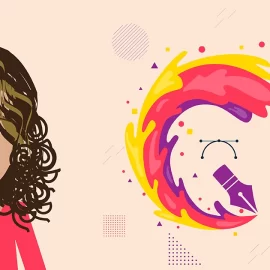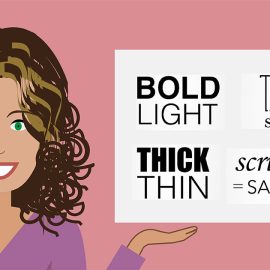
How to Become a Graphic Designer Without Going to School
A good design school will absolutely get you on the right track to becoming a talented, qualified professional. However, it’s simply not in the cards for everyone.
Fortunately, you can still fulfill your dream of becoming a graphic designer without a formal education, as long as you have the drive and dedication to pull it off.
Design school: Important or not?
As far as the design industry is concerned, the debate rages on. You can’t really blame people for thinking that design school is not really as important as the industry makes it out to be. After all, the most important aspect of creating fantastic design is creativity – something that people are born with and develop through time – and not something you learn from textbooks and modules.
But then again, your creativity alone will not really get you anywhere, if you don’t know the basics of design. No matter how unique your concepts are, you would also have to present them in the most professional way possible, especially if you want to make a serious career out of it.
This is where the value of proper design education comes in. It teaches you the basics and the ins and outs of every possible tool and theory that you will need to progress in the specific niche you want to concentrate on.
Design school drawbacks
The drawback to design school? It’s pretty simple. Not only does it cost a fortune to go to design school, it also takes up at least four years of your life. This is something that is just not possible for many people, especially if they don’t have the financial capacity.
A lot of kids have to start working the moment they reach legal age, so how can they keep their heads above water in the short term without having to sacrifice their long-term dream?
Here are a few steps that could help you get started and inch closer to your dream:
1. Building your foundation
You have to start with the basics. And for a career in graphic design, you have to start from scratch.
- Learn how to draw first. You don’t even have to enroll in an art class. Allocate at least 30 minutes of every day for a month just trying to draw. Once you’ve learned the basics and have gotten your hands used to the daily workout, move on to the next step.
- Learn graphic design theory.
- Next, you must learn a few basics in user experience.
- Text also plays a huge role in design, so you should also learn how to write. You’ll see mockups using the standard Lorem Ipsum text, but you have to be creative in every aspect. Get a feel for words. Give the audience the entire package by showing them the emotions they’re supposed to fell not just through the graphics, but through the words you use as well.
- Lastly, learn how to slaughter your work. This is one basic reality about graphic design that a lot of rookies fail to get.
When one design does not work, get rid of it and start anew. Don’t waste your creative juices by trying to improve something that’s not all that. Just let go of it and create something fresh and completely different.
These should pretty much sum up the foundation-building part of your training. Now that you’re equipped with the basics, it’s time to move on to more complicated things.
2. Mastering the software
You don’t think you could escape those computer programs, could you? Even if you want to go old school and would like to create things by hand, you can never deny the fact that the entire world has gone digital. Therefore, you also have to be prepared to create work digitally.
- Adobe Illustrator – Yes, it’s still not time to learn Photoshop, yet. Better start with Illustrator first. You’ll find so many video tutorials online and you can also try out a few textbooks.
- Adobe Photoshop – Finally, it’s time for you to learn how to use Photoshop. Again, you can find so many tutorials online but make sure you choose only the best.
There are so many other design programs out there but these are two of the most popular. You can try to learn the other programs one-by-one, as the need arises. For instance, if you’re going to do any print design, you’ll definitely need to learn Adobe InDesign.
3. Finding your specialty
As a design guru, you have to figure out what you want to specialise in. You don’t want to be the jack-of-all-trades when it comes to design. You want to be the master of a specific niche.
You have to choose one area for you to focus on, so that you could have a clearer path set out for you, especially when it comes to figuring out the next few steps that you’re going to take.
Logo design
Interested in building logos for a brand? This is a great choice. If you think that all there is to logo design is the logo itself, you are greatly mistaken. Most of the time, a designer is signed on board to create not just a logo but an entire brand identity. This means that you would also have to imagine that logo on a wall, on an office door, on a piece of stationery and everything else that comes with it.Hand lettering
If you enjoy hand lettering, there is a lot of demand for it right now. People are in love with hand crafted and personalised designs. Why? Because it brings a human element to design. In today’s digital world brands are seeking a handmade aesthetic.Mobile app design
Mobile apps are obviously very much in demand but you also have to be ready for a lot of competition.Web design
Obviously, this is one of the popular choices when it comes to specialisation. Feel free to jump from one website to another, taking note of the design aspects that you like the most about each website you see.
From here, it’s so easy to start building your own portfolio. Start out with a few concepts and then bring them to life. Find friends who may be needing your services and try to pitch some of your ideas. Mind you, the first few attempts at trying to get your first clients would be challenging. But once you make the first one happy, everything else will just fall into place.
Start your new career right now
Always be creating
Experience is very important. Nobody will want to hire you without it. Use your free time to create, learn and educate yourself. Find tutorials, try different side projects and focus on creating a large quantity of work.Be exceptional
Do something that separates you from the crowd. Find a niche or come up with a unique idea that will make you a hot commodity.Learn the business of design
If you’re planning on taking the freelance route, you should learn some basic business principles. You should focus on learning client negotiation skills, how to create a proposal or design brief, how to price your work, how to write a contract, how to track your time and how to invoice your client in a professional manner.
SOURCE: Creative Market



